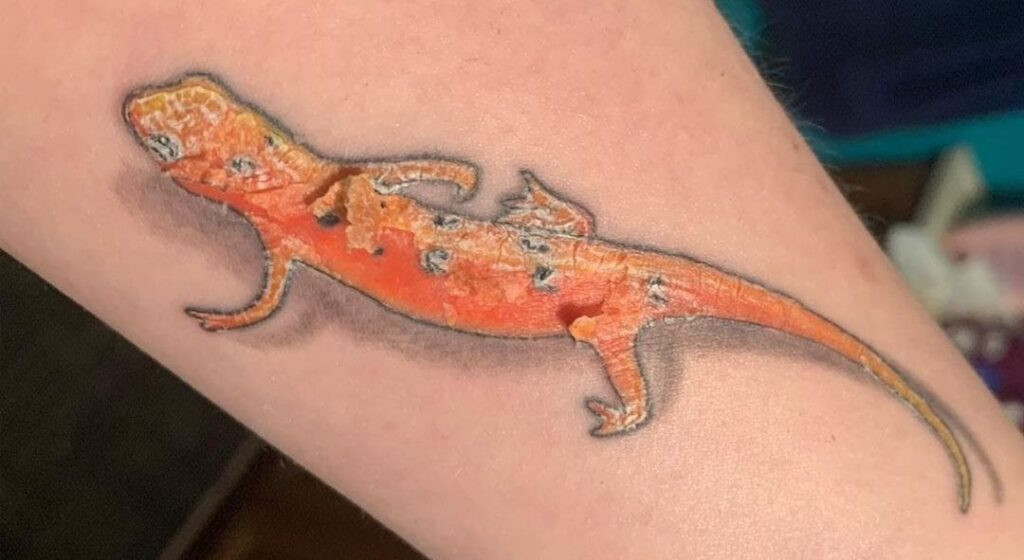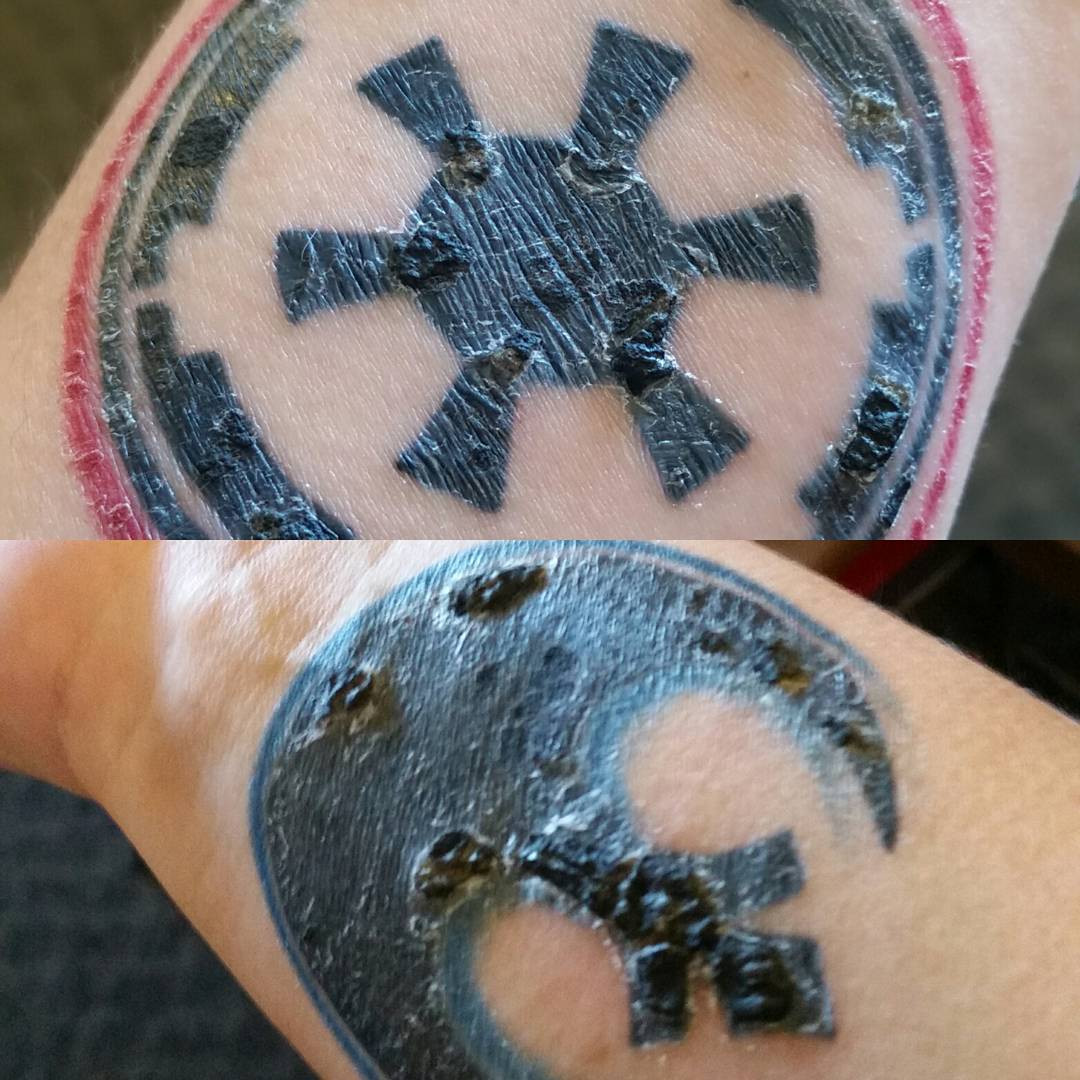When Does Your Tattoo Start Peeling, and how can you ensure proper healing? Tattoo peeling is a natural part of the tattoo healing process, a sign that your skin is regenerating after the tattooing process. At tattooat.com, we provide expert guidance on tattoo aftercare, including how to manage peeling and promote vibrant, long-lasting ink, along with understanding tattoo exfoliation, aftercare tips, and preventative measures.
1. What is Tattoo Peeling and Why Does It Happen?
Tattoo peeling is the shedding of the outermost layer of your skin (epidermis) as it heals after getting a tattoo. This process is similar to how your skin peels after a sunburn. The tattooing process involves needles repeatedly puncturing the skin, which causes trauma and triggers the body’s natural healing response. As the damaged skin cells die and are replaced with new ones, the old cells are shed, resulting in peeling.
- Natural Exfoliation: Your skin naturally exfoliates dead skin cells daily, but the tattooing process accelerates this exfoliation in the tattooed area.
- Ink and Peeling: During peeling, you may notice flakes of skin containing tattoo ink. This is normal and doesn’t mean your tattoo is losing color. The ink is deposited deep within the dermis, the layer of skin beneath the surface, which is not affected by the peeling.
- Mitigating Peeling: While some peeling is inevitable, minimizing it is essential to avoid distortions in your tattoo. Less peeling reduces the chance of scab formation and itchiness.
 Typical tattoo peeling
Typical tattoo peeling
2. When Does Tattoo Peeling Typically Begin?
Tattoo peeling typically starts around day four or five after getting inked, but this can vary from person to person.
-
Individual Variation: Some people might notice peeling as early as day two, while others may not experience it until a week later.
-
Factors Affecting Peeling: Several factors influence when and how much a tattoo peels, including:
- Location of the tattoo: Areas exposed to friction and movement, like elbows or fingers, may take longer to peel.
- Size and color of the tattoo: Larger and more saturated tattoos may peel more.
- Needle depth: The depth at which the needles penetrated the skin during tattooing can affect the degree of peeling.
- Aftercare: The use of tattoo bandages like Saniderm and specific aftercare products can influence the timing and extent of peeling.
-
Duration of Peeling: Normal tattoo peeling can last anywhere from two days to one month. The wet tattoo healing method can help shorten the duration and reduce the amount of peeling.
3. How Long Does Tattoo Peeling Last?
The duration of tattoo peeling can vary, but typically it lasts for one to two weeks. Several factors influence this timeline:
- Individual Healing Rate: Everyone’s skin heals at a different pace. Factors such as age, overall health, and immune system function can affect how quickly your tattoo peels.
- Tattoo Size and Complexity: Larger and more detailed tattoos may take longer to peel due to the increased trauma to the skin.
- Aftercare Practices: Consistent and proper aftercare can help speed up the healing process and reduce the duration of peeling.
- Environmental Factors: Humidity, temperature, and exposure to sunlight can also impact how long your tattoo takes to peel.
4. What is the Wet Tattoo Healing Method and How Does it Affect Peeling?
The wet tattoo healing method involves using a dermal tattoo bandage like Saniderm to protect the new tattoo and promote optimal healing. This method significantly affects peeling.
- Protection: Saniderm protects the tattoo from contaminants like bacteria, dirt, and pet dander, reducing the risk of infection.
- Moisture Retention: It keeps the body’s natural healing fluids at the wound site, preventing them from forming scabs. This creates a moist, nutrient-rich environment for healing.
- Permeability: Saniderm allows oxygen and water vapor to pass through while blocking water and contaminants, which is crucial for proper healing.
- Minimized Peeling: By locking in the body’s natural healing fluids, Saniderm moisturizes the tattoo and minimizes scabbing, peeling, and scarring.
Using Saniderm can significantly reduce the amount and duration of peeling compared to traditional dry healing methods.
 Tattoo Scabbing
Tattoo Scabbing
5. What Should You Do While Your Tattoo is Peeling?
Proper care during the peeling phase is crucial for ensuring your tattoo heals correctly and looks its best. Here are some essential DOs:
5.1. Wear Loose Clothing
Wearing loose clothing can minimize friction and irritation on the healing tattoo.
- Avoid Rubbing: Tight clothing can rub against your tattoo, potentially pulling off skin prematurely.
- Comfort: Opt for loose and comfortable clothing throughout the peeling process.
- Reduced Irritation: The less contact with the tattoo, the better.
5.2. Allow Natural Healing
Let your body heal naturally and avoid interfering with the process.
- Patience: Your tattoo will likely look dry, patchy, and flaky for a few weeks.
- Time to Heal: Remember that your skin has undergone trauma and needs time to recover.
- Aftercare Routine: Following a careful tattoo aftercare routine can help your tattoo heal faster.
5.3. Keep the Area Clean
Maintaining cleanliness is vital to prevent infection.
- Mild Soap: Clean your tattoo with a mild, fragrance-free soap before and after each new bandage application if using the wet healing method.
- Remove Contaminants: Regularly cleanse the tattoo to remove dirt, plasma, blood, or oil that might clog your pores.
- Clean Environment: Wear clean clothes and use fresh towels and sheets.
5.4. Keep Your Tattoo Moisturized
Moisturizing helps prevent itchiness and keeps the skin supple.
- Aftercare Product: Use a mild and gentle aftercare product formulated specifically for tattoos, like Sanibalm.
- Avoid Petroleum-Based Products: Petroleum-based products can clog pores.
- Application: Apply the product directly on the tattoo only, keeping the surrounding area dry if using a bandage.
6. What Should You Avoid Doing While Your Tattoo is Peeling?
Certain activities can hinder the healing process and potentially damage your tattoo. Here are some critical DO NOTs:
6.1. Do Not Pick or Pull on the Scabs/Flakes
Resist the temptation to pick at peeling skin.
- Attachment to Healthy Skin: Scabs and flakes are often still attached to healthy skin.
- Risk of Reopening: Premature removal can reopen the wound and cause bleeding.
- Distortion of Design: This can disturb the ink and distort the tattoo design.
6.2. Do Not Itch, Scratch, or Rub Your Peeling Tattoo
Avoid any actions that could introduce bacteria or damage the healing skin.
- Bacteria Transfer: Fingernails can harbor bacteria, risking infection.
- Premature Peeling: Scratching can peel off scabs prematurely, damaging the tattoo design.
- Increased Itchiness: Rubbing can further irritate the skin, leading to more itching.
6.3. Do Not Submerge Your Tattoo in Water for Extended Periods
Prolonged water submersion can interfere with healing.
- Weakened Adhesive: Submerging the tattoo in water can weaken the adhesive if you’re using a bandage like Saniderm.
- Contamination Risk: Loosened adhesive can allow water, soap, dirt, and bacteria to enter the wound.
- Infection Risk: Contaminants can increase the chance of developing a tattoo infection.
7. What are the Signs of a Bad Tattoo Healing Process?
Knowing the signs of improper healing is essential for addressing issues promptly.
- Flu-Like Symptoms: Fever or chills can indicate an infection or allergic reaction. Seek medical attention ASAP.
- Red, Swollen Skin: While some redness and swelling are normal, persistent inflammation days after getting the tattoo could indicate a problem.
- Excess Fluid: While some oozing of ink, plasma, and blood is normal initially, continuous leaking of fluid (especially if green or yellowish) could indicate infection.
- Itchy Bumps or Hives: These can be a sign of an allergy to the ink or aftercare products. Allergic reactions can appear weeks, months, or even years later.
- Scarring: A properly healed tattoo should have no signs of scarring. Scabs are a natural part of the healing process, but excessive scarring is not.
If you notice any of these signs, consult your tattoo artist or a healthcare professional immediately.
8. What Should You Put on a Tattoo While It’s Peeling to Aid Healing?
Using the right products can significantly aid the healing process.
- Keep it Clean: Use a gentle, fragrance-free, antibacterial soap to clean the tattoo.
- Tattoo-Specific Aftercare Products: Apply a light layer of water-based cream designed for tattoo aftercare, such as Sanibalm, to relieve discomfort.
- Protect from Sun Exposure: Use a broad-spectrum sunscreen (30 SPF or above) to protect the skin from harmful UV rays, which can cause fading.
- Skip Tanning Beds: Avoid tanning beds to prevent skin damage and tattoo fading.
- Consult a Dermatologist: If you notice any unusual changes or reactions, consult a dermatologist for guidance and treatment.
9. What are the Key Differences Between Tattoo Peeling and Tattoo Scabbing?
Understanding the difference between peeling and scabbing can help you better care for your tattoo.
| Feature | Tattoo Peeling | Tattoo Scabbing |
|---|---|---|
| Appearance | Thin, flaky skin shedding, similar to sunburn peeling | Thick, raised, crusty patches |
| Cause | Natural exfoliation of damaged skin cells | Formation of a protective crust over a deeper wound |
| Severity | Mild and expected | Can indicate a more significant injury or improper aftercare |
| Risk | Low risk of affecting the tattoo’s appearance | Higher risk of ink loss and scarring if picked or disturbed |
| Management | Keeping the area moisturized and avoiding irritation | Avoiding picking, keeping the area clean and moisturized, and protecting from infection |
10. Frequently Asked Questions (FAQs) About Tattoo Peeling
10.1. Is it normal for my tattoo to peel in large chunks?
Yes, it’s normal for tattoos to peel in large chunks, especially if it’s a larger tattoo or in an area with less skin flexibility. However, avoid pulling the peeling skin, as it can damage the tattoo.
10.2. Can I shower while my tattoo is peeling?
Yes, you can shower while your tattoo is peeling. Use lukewarm water and a mild, fragrance-free soap. Avoid prolonged soaking and gently pat the area dry.
10.3. What happens if I accidentally pick a scab off my tattoo?
If you accidentally pick a scab, gently clean the area with antibacterial soap and apply a thin layer of tattoo aftercare balm. Monitor for signs of infection and consult your tattoo artist if you have concerns.
10.4. How can I tell if my tattoo is infected during the peeling stage?
Signs of infection include excessive redness, swelling, pain, pus, and fever. If you experience these symptoms, seek medical attention immediately.
10.5. Should I apply sunscreen to my tattoo while it’s peeling?
No, avoid applying sunscreen to a peeling tattoo. Sunscreen should only be applied to fully healed tattoos. Keep the peeling tattoo covered with loose clothing to protect it from the sun.
10.6. Can I exercise while my tattoo is peeling?
Avoid excessive sweating and friction on the tattooed area. Wear loose clothing and clean the tattoo immediately after exercising.
10.7. Is tattoo peeling more intense with certain ink colors?
Peeling intensity can vary based on the amount of ink used and the tattoo’s size, rather than specific ink colors.
10.8. What type of moisturizer is best for a peeling tattoo?
Use a water-based, fragrance-free moisturizer specifically designed for tattoo aftercare. Avoid petroleum-based products, as they can clog pores.
10.9. How often should I moisturize my tattoo while it’s peeling?
Moisturize your tattoo 2-3 times a day, or whenever it feels dry. Apply a thin layer of moisturizer to avoid over-saturation.
10.10. Can tattoo peeling affect the color of my tattoo?
Normal tattoo peeling should not significantly affect the color of your tattoo. However, picking scabs can cause ink loss and affect the tattoo’s appearance.
Discover Expert Tattoo Aftercare at tattooat.com
Understanding when your tattoo starts peeling and how to manage the healing process is crucial for maintaining the beauty and integrity of your ink. At tattooat.com, we offer a wealth of resources to guide you through every step of tattoo aftercare. From selecting the right artist to choosing the best aftercare products, we’re here to support you.
Ready to dive deeper into the world of tattoos? Explore our extensive collection of tattoo designs, find talented artists in your area, and discover expert tips for ensuring your tattoo remains a vibrant expression of your unique style. Visit tattooat.com today and embark on your tattoo journey with confidence.
Address: 1825 SW Broadway, Portland, OR 97201, United States
Phone: +1 (503) 725-3000
Website: tattooat.com
